
Right now, it’s baseball season in America! Long known as ‘America’s Pastime’, baseball is practically a staple of this country’s history. Sure, some may argue that the sport is becoming less popular in recent years… that and there’s also been the frequent amount of controversies surrounding players who have been using illegal substances (e.g. steroids). Despite this, though, I’ve been a fan of the sport ever since I was a kid, and I assure you that this mindset of mine won’t be changing anytime soon. And so, to celebrate the grand old game, I decided to do a big 2-part review extravaganza in which I discuss some of the most classic baseball films of all-time. It’s a two-parter because I have 20 films (yes, 20!) to talk about. I wanted to cover as many films as I possibly could, and I believe that I’ve managed to assemble a comprehensive list of 20 of the biggest baseball films of all-time. Now, for the record, I’m well-aware that by covering all these films, I probably will repeat myself on a few occasions because of the similarities that often do occur between a few of these films. However, I tried to avoid that, for the most part, by covering baseball films that span all sorts of genres and audiences, ranging from the more family-friendly affairs to those that are geared more towards adult audiences. With that in mind, grab your gloves and start whistling a classic baseball tune like ‘Sweet Caroline’ by Neil Diamond or ‘Centerfield’ by John Fogerty and join along with me as I review some of the biggest sports films of all-time that are all about America’s Pastime. Yes, to quote the classic song by Terry Cashman, “We’re Talking Baseball!” (or Softball if you’re referring to the version of the song that was made for the classic Simpsons episode ‘Homer at the Bat’).
Just to note, I will be covering these films in chronological order.
THE PRIDE OF THE YANKEES (1942)
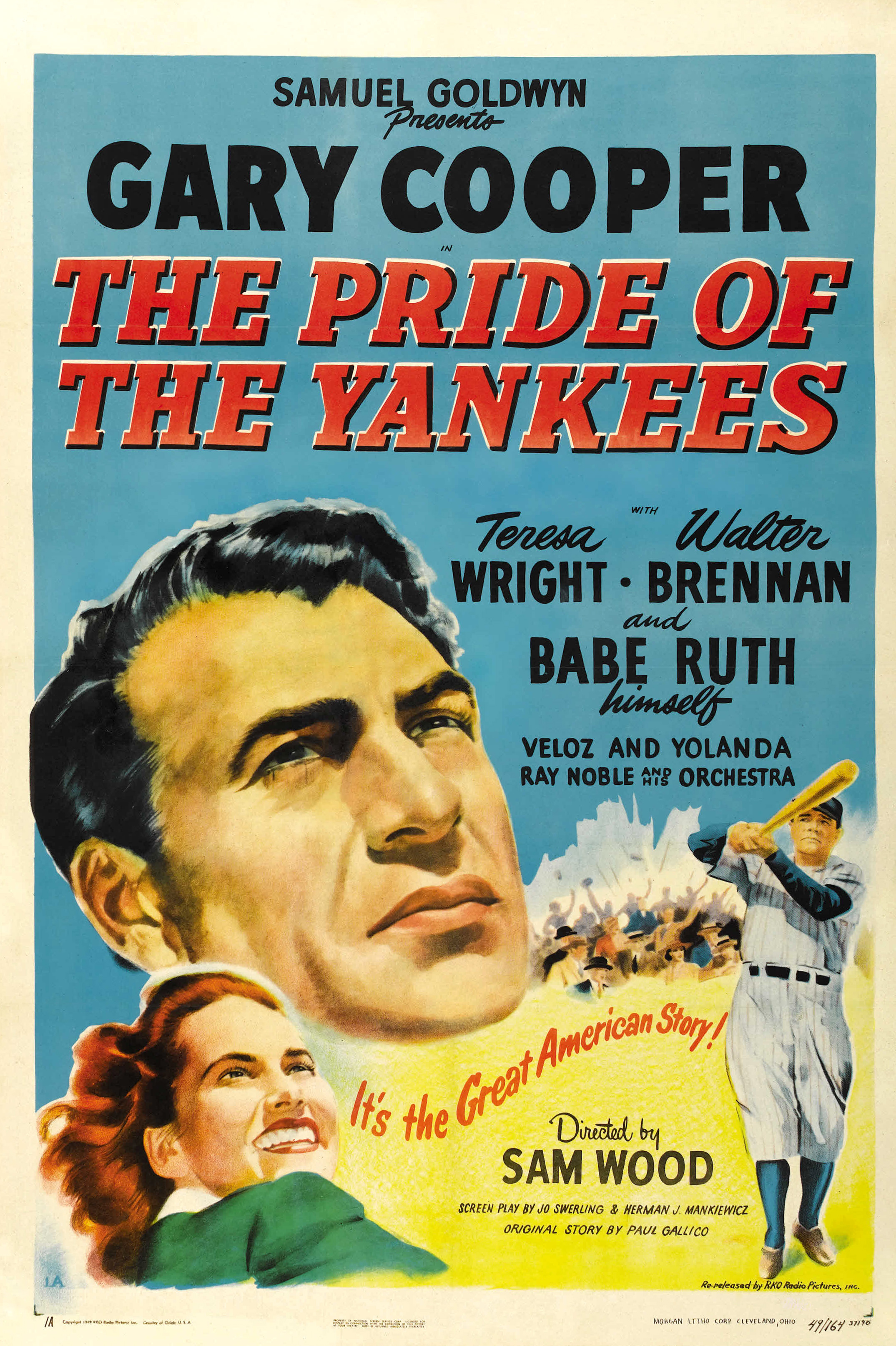
We start things off today with the oldest film that we’ll be covering in this two-part retrospective. In fact, this film just celebrated its 75th anniversary; yes, we’re talking about The Pride of the Yankees, which tells the story of New York Yankees legend Lou Gehrig. During his tenure in the Bronx, he became well-known for his hitting prowess and impressive resilience, the latter of which helped him set a record for the most consecutive games played at 2,130, which was eventually surpassed years later by Cal Ripken Jr. Sadly, for Gehrig, both his streak and career ended prematurely when he learned that he was suffering from ALS. He died just a few years after his iconic speech that he made at Yankee Stadium in which he proclaimed himself to be the ‘luckiest man on the face of the Earth’. The film is basically a full-on biopic of Gehrig’s life; in other words, it admittedly focuses more on his personal life than his playing career. This is mainly because, prior to filming, some of the cast and crew weren’t too familiar with baseball. Thus, the film has gotten some criticism over the years for its overall handling of its baseball scenes. Plus, from a modern perspective, there are admittedly times where the film shows its age, namely through some moments that, nowadays, come off as being unintentionally funny. Still, this is a genuinely engaging look at the life of Lou Gehrig, who’s portrayed excellently by Gary Cooper. He has terrific chemistry with Teresa Wright, who does an equally fantastic job in the role of Gehrig’s wife, Eleanor. They even got Gehrig’s equally famous teammate, Babe Ruth, to play himself in the film. And really, at that point in history, who better to play Babe Ruth than Babe Ruth? In conclusion, while some parts of it haven’t exactly aged well, The Pride of the Yankees is still a solidly made biopic that even manages to hit a few effective emotional cords here and there once it begins to get into Gehrig’s ALS-based decline.
Rating: 4/5
THE BAD NEWS BEARS (1976)

When it comes to films that are often regarded as some of the staples of their genre, The Bad News Bears is that film for the baseball film genre. This classic tale of a drunken coach of a Little League team made up entirely of misfits still holds up quite well today. Part of the reason why is simple; as a comedy, this film is an absolute riot. And a lot of the film’s best humor comes from the interactions between its child stars. Sure, the film’s adult stars get some great laughs too, headlined by Walter Matthau as the titular Bears’ boorish coach, Morris Buttermaker, but the kids are ultimately the stars of the show here. Director Michael Ritchie did an excellent job at casting the film’s young cast, headlined by a pair of rising stars in Tatum O’Neal, who plays the Bears’ sole female player, pitcher Amanda Whurlizer, and Jackie Earle Haley as the smoking, motorcycle-riding outfielder Kelly Leak. With that in mind, the other thing to note about this film is that even though it’s rated PG, it’s got quite the edge to it. The kids often swear as much as the adult characters do and there are admittedly a few mean-spirited moments here and there. Thus, it’s understandable as to why some may be drawn off by this film’s unfiltered nature. Still, amidst all the crass humor, the film still has a fair amount of heart to it. You’re fully behind the Bears as they rise from the bottom of the league to the top. And at the end of the day, the film’s crude sense of humor ends up helping it maintain a more natural atmosphere compared to other entries in the genre. Thus, The Bad News Bears still stands as one of the most classic baseball films of all-time. It’s easy to see why several of the baseball films that came after it clearly owe a lot to it and its tale of pint-sized ballplayers.
Rating: 4.5/5
The original Bad News Bears was one of the surprise hits of its year, grossing over $42 million at the box-office. Thus, it ended up getting a pair of sequels which were released the following two years, albeit without the involvement of Matthau and O’Neal. The first of these sequels was 1977’s The Bad News Bears in Breaking Training. The plot revolved around the Bears as they traveled to Houston to take on a local team known as the Toros in the Houston Astrodome. William Devane starred as the team’s new coach, who just so happened to be Kelly Leak’s estranged father Mike. It didn’t fare as well with critics compared to the original but it wasn’t outright panned, either. That distinction instead went to the 1978 ‘threequel’, The Bad News Bears Go to Japan. The title speaks for itself; the Bears head to Japan led by a promoter played by Tony Curtis. Only about half of the young cast that made up the original film’s Bears team returned for this film, which was basically a critical disaster. How bad was it, you ask? In a 2017 interview on Reddit, even Jackie Earle Haley called it the ‘worst film ever made’. That’s saying a lot considering that this came from one of the film’s main stars. Though I must admit, I watched this film first before the original. However, that’s only because I own a DVD of it… for some reason. Admittedly, it’s been years since I’ve seen the film and I don’t really plan on rewatching it anytime soon. Anyway, getting back on track, the franchise then moved to TV via a sitcom that lasted for two seasons on CBS from 1979-1980. Jack Warden starred as Buttermaker and a notable member of the cast was a young Corey Feldman as third baseman Regi Tower. Finally, the franchise was revived years later in 2005… but we’ll get into that one next time.
BULL DURHAM (1988)

Next up, we have a film that is often considered to be one of the greatest baseball films of all-time. The first of two baseball films directed by Ron Shelton which will appear on this list, Bull Durham stars Tim Robbins and Kevin Costner as hot-shot rookie pitcher Ebby Calvin ‘Nuke’ LaLoosh and aging veteran catcher Crash Davis, respectively. These two players constantly butt heads with one another while they’re teammates on the minor-league ballclub known as the Durham Bulls (hence the title of the film). They even get caught in a love triangle with Bulls groupie Annie Savoy (Susan Sarandon), who has a tradition where she has an affair with one of the Bulls’ players every year to help them play better. But is Bull Durham truly as great as many say it is? Yeah, pretty much. One of the key reasons for this is thanks to the charismatic performances from Robbins, Costner, and Sarandon. All three work off each other extremely well, whether it’s Robbins and Costner interacting on the ballfield or when either of them romances Sarandon off-field. And the screenplay by Ron Shelton is full of hilarious bits of dialogue, like when an argument between LaLoosh and Davis on the pitcher’s mound soon gets other members of the team involved. This then leads to a quite random discussion about everything from the first baseman requesting a rooster sacrifice to break the supposed curse on his glove to what kind of gift to get their teammate, who’s about to get married. Ultimately, though, the screenplay manages to find a nice balance in terms of the film being both a baseball story and a romantic comedy. Thus, Bull Durham is a highly entertaining baseball rom-com thanks in no small part to its three leads and solid direction from Ron Shelton.
Rating: 4.5/5
EIGHT MEN OUT (1988)
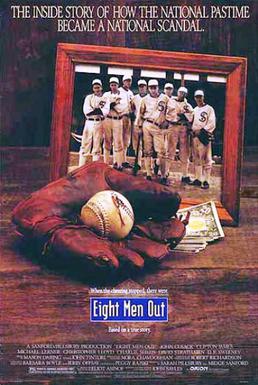
Eight Men Out tells the true story of one of the most infamous incidents in baseball history. It involved the 1919 Chicago White Sox, who were heavy favorites that year to win the World Series against the Cincinnati Reds. However, to the surprise of many, they ended up losing the series 5 games to 3. It wasn’t until afterward when it was discovered that several players had conspired with gamblers to throw the series for money; thus, newly appointed commissioner Kenesaw Mountain Landis banned the eight players who were tied to this plot from baseball for life. And through this film, these events were brought to life in a well-layered story that explored the humanity of the eight men caught up in the scheme. Because as it turns out, their actions were in protest of their owner’s cheapskate methods when it came to paying them despite their success on the field. Thus, despite the extremity of their actions, some of the players do prove to be rather sympathetic while still being reprimanded in the end for what they’ve done. Some players weren’t even ‘fully in’ on the fix. Third baseman Buck Weaver refused to take part in it while outfielder ‘Shoeless Joe’ Jackson, touted by many as one of the greatest ballplayers of all-time, was basically shoehorned into the plot due to his illiteracy. And these characters are portrayed excellently by a stacked ensemble cast, including John Cusack, Michael Rooker, Christopher Lloyd, David Strathairn, and Charlie Sheen. All this, paired with excellent direction by John Sayles, makes Eight Men Out a bona fide classic. Because while it may focus in on one of the darkest moments in the history of the sport, it manages to find the humanity within a bunch of players who became some of the most infamous names in baseball history.
Rating: 5/5!
FIELD OF DREAMS (1989)
I’m sure many of you will remember this one. The second major baseball film of Kevin Costner’s career is arguably just as iconic as Bull Durham. In it, Costner stars as a farmer from Iowa named Ray Kinsella who hears a mysterious voice one day while out in his corn field; “If you build it, he will come”. Ray ends up interpreting this as a sign to build a baseball field on his lot, which soon leads him on a journey of self-discovery as he continues to try and understand the mysterious voice’s demands. And this journey ends up producing one of the best baseball films of all-time. Now, I’m aware that some may find this film to be a bit too overly sentimental. And while I do understand where those people are coming from, I really appreciate this film’s earnest nature. It knows it’s sentimental, and it’s all built around an excellent story (which was adapted from the 1982 novel Shoeless Joe by W.P. Kinsella) of one man’s quest for emotional catharsis, which in turn is tied to the infamous ‘Black Sox Scandal’. Yes, this is the second film on this list (second in a row, even) that delves into this event after Eight Men Out. And it ultimately goes for a more light-hearted approach to the subject as we see the eight players, primarily Shoeless Joe Jackson (Ray Liotta), be given the chance to play again when they appear (as ghosts) to play on Ray’s field. The film is well-shot, well-directed, and features fantastic performances from the likes of Kevin Costner as Ray, Amy Madigan as Ray’s loving and supportive wife Annie, and James Earl Jones as a reclusive author named Terence Mann who ends up becoming connected to Ray’s adventure. Thus, while some may find Field of Dreams to be a bit too saccharine from a modern perspective, I’d say that it still stands as not only one of the best baseball films ever made, but also one of the best films ever made period. It’s easy to see why this film ended up earning three Oscar nominations the year of its release, including one for Best Picture.
Rating: 5/5!
MAJOR LEAGUE (1989)

And here we have another baseball comedy classic, Major League, which centers on the Cleveland Indians. The plot focuses on the efforts of their new owner, a former Vegas showgirl, to have the team perform so badly (or, in other words, worse than they’re already doing) that she can move them to Miami. Thus, she recruits an eccentric collection of misfits who soon end up banding together to turn things around. Like Bull Durham, this one’s full of great comedic dialogue, from the witty remarks by Indians’ broadcaster Harry Doyle, played by real-life Milwaukee Brewers broadcaster Bob Uecker, to the highly superstitious pre-game warm-ups by outfielder Pedro Cerrano (“It’s very bad to steal Jo-Bu’s rum!”) And to top it all off, the film boasts an excellent ensemble cast, highlighted by Charlie Sheen as hot-headed fastball pitcher Ricky ‘Wild Thing’ Vaughn, Tom Berenger as aging catcher Jake Taylor, and Wesley Snipes as the team’s fast-talking base stealer Willie Mays Hayes. In short, it’s clear to see why this highly entertaining screwball comedy was one of the most popular baseball films of its time, and it was soon followed by a pair of sequels. Most of the cast returned for the 1994 sequel, Major League 2, save for Snipes who was replaced by Omar Epps. The film even saw a change in studios as it was released by Warner Bros instead of Paramount. Then, in 1998, a third film was made, Major League: Back to the Minors; however, this one focused on the Minnesota Twins’ AAA ballclub and only featured a select few from the previous films’ ensembles. Thus, neither film ended up being as successful as the original, though I’d argue that Major League II ain’t that bad (3.5/5). As for Back to the Minors… I’ve only seen a small part of it. At the end of the day, it’s all about that original classic.
Rating: 4.5/5
THE BABE (1992)
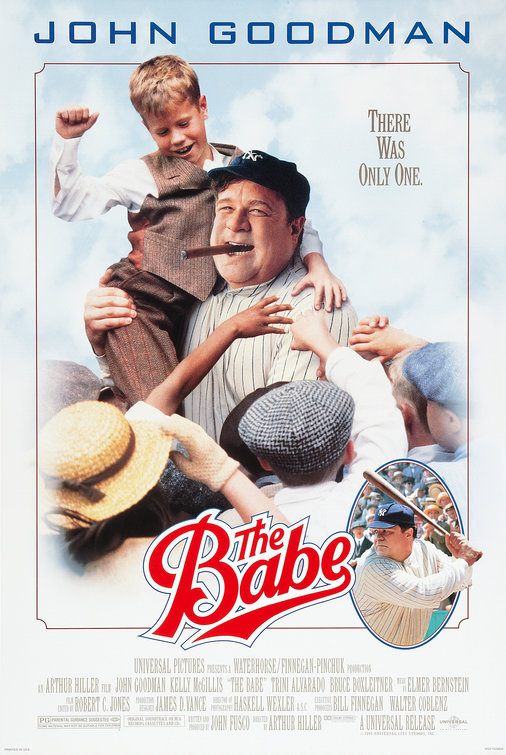
This next film’s title says it all; The Babe focuses on the baseball legend that is Babe Ruth. The film follows ‘the Sultan of Swat’ from his early years as an orphan in Baltimore to his brief tenure with the Red Sox all the way to the infamous trade that sent him to the New York Yankees, where he truly became a legend. However, the film itself has been subjected to some polarizing reviews from critics who weren’t big on the film’s overall portrayal of ‘the Colossus of Clout’. And, well, they’re kind of right. Now, for the record, John Goodman is a great fit in the role of Ruth, and the film at least does a good job of showcasing Ruth’s talent as a baseball player. As for his personal life, though, that’s another story. The film portrays Ruth as a person who is entirely lacking in social skills; a guy who constantly gets drunk and depressed while also being crude around his teammates, friends, and family. And from what I’ve read, this isn’t how the real Babe Ruth was at all; sure, he could be quite stubborn at times, but he loved life just as much as he loved the game. By comparison, the Babe Ruth in this film is… kind of pathetic. And while the film’s finale sees him slamming three home runs despite being past his prime, it basically concludes with him as a broken-down shell of his former self. Thus, the biopic that was intended to honor one of the game’s all-time greats ends up being a rather depressing affair. I mean, it’s filmed decently enough and I’ll admit that I usually do watch it any time that it comes on TV. Still, it’s hard to sympathize with the Babe Ruth that’s portrayed in this film.
Rating: 3/5
A LEAGUE OF THEIR OWN (1992)
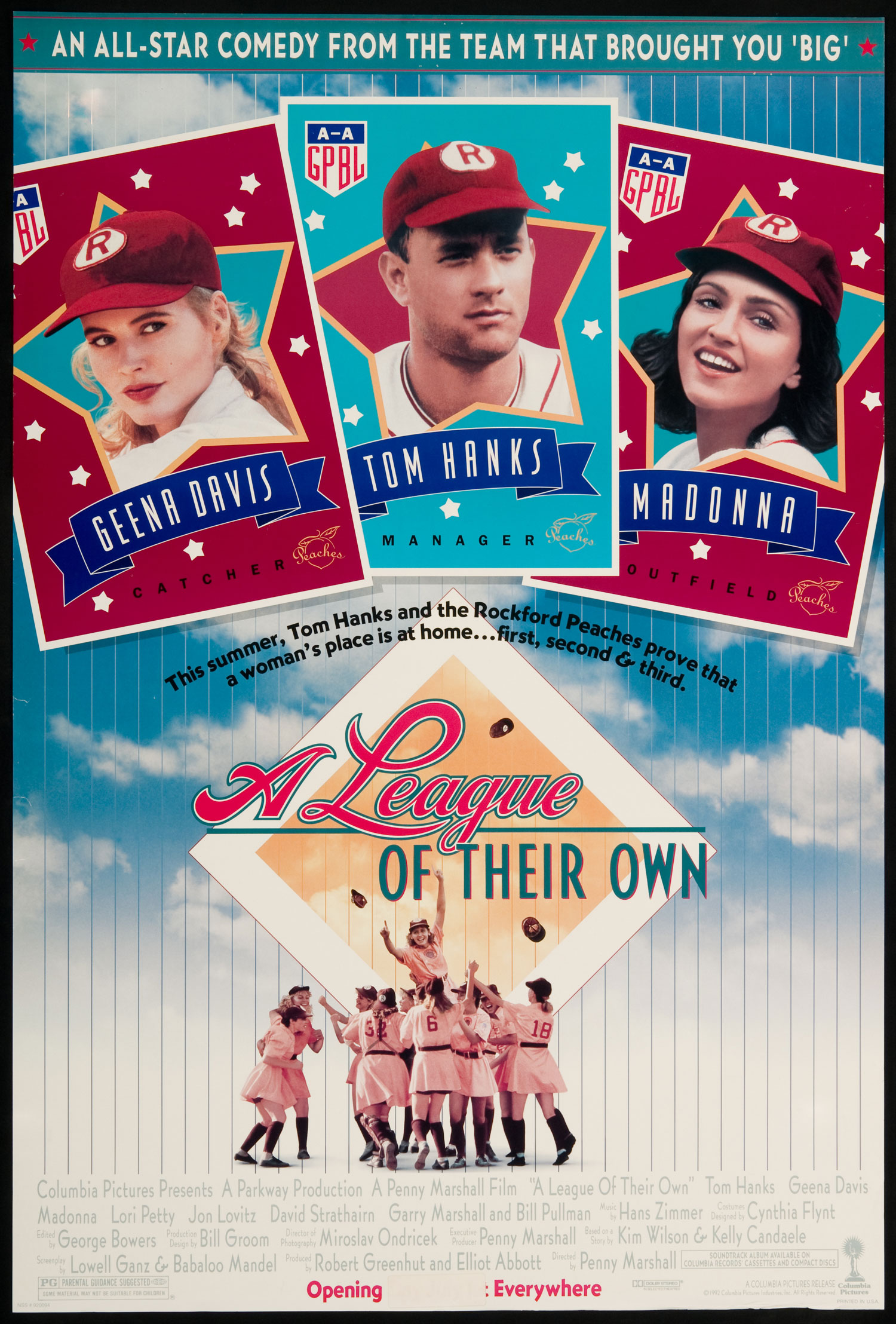
Now here’s a classic! A League of their Own is director Penny Marshall’s take on the All-American Girls Professional Baseball League, formed during World War II when members of the major leagues were drafted into the army. The league was formed primarily to help keep baseball going in America during this time, and while the story in this film is a fictional one, it’s a great look back at this fascinating point in the history of the game where the ladies were the stars of the show. Case in point, the film boasts an excellent ensemble cast, highlighted by Geena Davis as main protagonist Dottie Hinson, arguably the league’s best player, and Lori Petty as Dottie’s sister Kit, who constantly finds herself under her sister’s shadow. This results in solid on-screen camaraderie between Davis and Petty, which ends up turning into an engaging rivalry once the latter is traded to another team. And, of course, there’s also Tom Hanks as Jimmy Dugan, the hard-drinking manager of the Rockford Peaches, the team that Dottie and Kit initially end up on. Hanks is great as the gruff manager/former ballplayer who’s down on his luck while also providing us with one of the greatest lines in film history; “There’s no crying in baseball!” But while there may not be any crying in baseball, this film is built around a solid emotional core. It all culminates in a satisfying ending where the surviving members of the AAGPBL revel in getting a brand-new exhibit at the Baseball Hall of Fame in Cooperstown, New York. Thus, with a great ensemble cast, excellent direction from Penny Marshall, and empowering themes that still hold strong today, A League of their Own is very much a timeless classic.
Rating: 4.5/5
ROOKIE OF THE YEAR (1993)

I’m sure most 90’s kids will remember this one; Rookie of the Year. Thomas Ian Nicholas (Kevin from the American Pie series) stars as Henry Rowengartner, a middle-schooler who suffers a devastating arm injury when trying to catch a fly ball. When his arm heals, though, he finds that he can now throw a baseball at the same velocity of an MLB pitcher. Thus, he ends up getting recruited by his hometown team, the Chicago Cubs, in the hopes of turning their season around. Like the other family-friendly baseball films of the time, the film is admittedly rather silly. In fact, I’d say that director Daniel Stern (AKA Marv from the first two Home Alone films) tries a bit too hard sometimes with the humor. And yet, also like those other family-friendly films, I’d argue that this film is still a charming little romp. Despite what I just said earlier about some of the film’s overt attempts at humor, there are some genuinely funny moments in this film, like when Henry is forced to go to bat, manages to get on base, and then proceeds to taunt the opposing pitcher (“Pitcher’s got a big butt! Pitcher’s got a big butt!”) Plus, the whole subplot involving Henry and his mother, who we learn is quite a badass herself, elicits some legitimately sweet results. Thus, Rookie of the Year is still an entertaining entry in this genre. Yeah, the premise is kind of ridiculous, but if you’re able to accept its surreal nature, you’ll find it to be an enjoyable family film. Plus, up until the Cubs finally won the World Series for the first time in over a century this past October, this was one of the few instances where the Cubs were ‘World Series Champions’… sure, it’s only on film but, hey, what are you going to do?
Rating: 4/5
THE SANDLOT (1993)
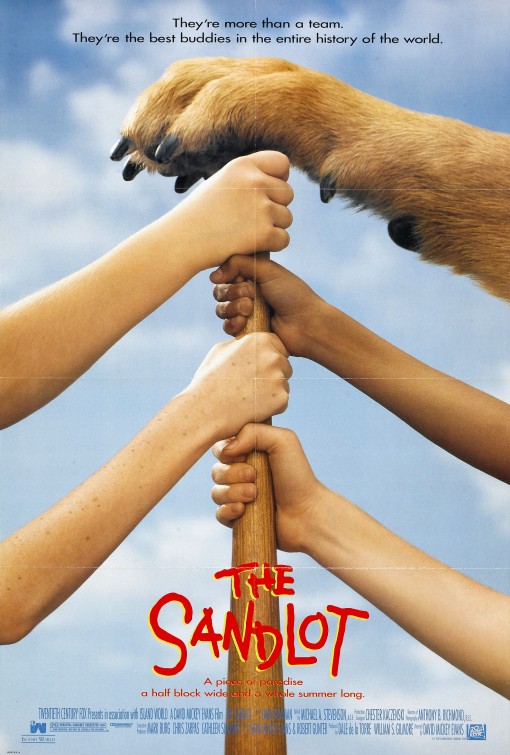
Ah, The Sandlot… the all-American classic story of a bunch of kids and the many adventures that they had on a sandlot field in the summer of 1962. Though would you believe that this film didn’t do so well with critics when it was released in 1993? It only has a 58% rating on Rotten Tomatoes, and that’s crazy! This film is one of the genre’s greatest outings. Sure, maybe it’s ‘derivative’ in some places, as some of its biggest critics have said. Still, this film delivers on exactly what it wants to be; an affectionate and nostalgic tribute to Americana and life in the 60’s. The film has a lovable cast of main characters and is full to the brim with classic moments, from spectacled ‘Squints’ pulling a ‘savage’ move on his crush by feigning unconsciousness and kissing her as she does CPR on him to the boys making a dumb decision by using chewing tobacco, which then leads to them barfing on a carnival ride. And, of course, there’s also the classic third act of the film, in which the boys try to retrieve a valuable baseball (owned by main protagonist Scotty’s father and signed by the one and only Babe Ruth) from the backyard of the house behind the left-field fence, where a supposedly vicious dog named ‘The Beast’ resides. They try all sorts of plans that go nowhere until their leader, Benny ‘The Jet’ Rodriguez, braves the storm to collect the ball after being visited by the one and only Babe (“Heroes get remembered, but legends never die…”). It all ends with a great scene in which Benny and Scotty talk with the owner of the house, Mr. Myrtle, played by James Earl Jones in an excellent cameo, and realize that he isn’t such a ‘mean, old man’ as they were led to believe. And, really, what more can be said about this iconic film that hasn’t been said already? If you want to see one of the purest portrayals of ‘America’s Pastime’ on the big screen, The Sandlot is just the film for you.
Rating: 5/5!
Now, while I’m not reviewing them, I also wanted to briefly go over the two direct-to-video sequels to this film that were released in the early 2000’s. The first, The Sandlot 2, was released in 2005. It was once again directed by David Mickey Evans, who also served as the narrator for both films in which he played the older self of the main character, Scotty Smalls in the first and Johnnie Smalls in the second. However, it’s admittedly just the same general story as the first Sandlot. There’s a group of kids who play baseball on the local sandlot field, there’s a scene where they play a rival team, another scene where they go to the carnival and get into trouble there, and of course, a subplot in which they must retrieve something valuable from Mr. Myrtle’s yard, which is guarded by another big, scary dog. The only major differences here are that it takes place in the 70’s, the valuable object is a model of a space shuttle, and a few girls join the team. Other than that, it’s mostly just a clone of the first film; still, from what I remember, it was harmless enough. The other sequel, The Sandlot: Heading Home, was released in 2008. Directed by William Dear (who directed another baseball film which we’ll be discussing in Part 2), this film focuses on a hotshot major league ballplayer who gets hit by a wild pitch during batting practice, which knocks him out and results in him being ‘sent back in time’ to when he was a kid. So, at the very least, this film isn’t just a copy of the first film. Heck, I’d say that the whole character arc of the main protagonist, who goes from being a selfish prick to a more compassionate human being, was generally well-handled. They even manage to have a cameo from Chauncey Leopardi as Squints and an appearance by Benny ‘The Jet’ Rodriguez, albeit here he’s played by Danny Nucci this time around instead of Mike Vitar (or, given that it’s the older Benny, Mike’s brother Pablo, who played the part in the first film’s final scene set years later in Dodger Stadium).
And that’s the end of Part 1 of Rhode Island Movie Corner’s Baseball Film Review Extravaganza. Check back soon for Part 2, in which I’ll be delving into films like Angels in the Outfield, Fever Pitch, and Moneyball.
No comments:
Post a Comment